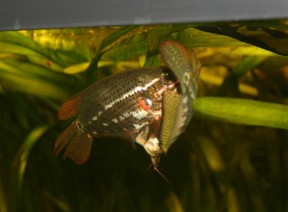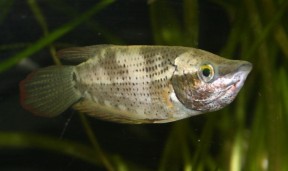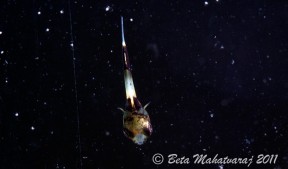Ctenops nobilis
Frail Gourami
Classification
Order: Perciformes Family: Osphronemidae
Distribution
Described from Sikkim state, northeastern India and also known from West Bengal, Bihar and Assam states plus northern Bangladesh and, more recently, Nepal. All records thus pertain to the Ganges and Brahmaputra river systems in the region north of their confluence.
Habitat
The majority of the area over which this species occurs mostly experiences a temperate climate with heavy rainfall/humidity and a pronounced monsoon period between June and September. Average air temperatures tend to fall within the range 59 – 90°F/15 – 32°C depending on locality and time of year, though in the northern extreme of its range it can be significantly cooler during winter. Many of its habitats are therefore subject to severe seasonal alteration in terms of water depth, volume and flow.
At the type locality of the catfish Pseudolaguvia muricata in northern Bangladesh the habitat comprised a slow-moving, shallow stream containing clear water with a substrate of sand and organic detritus. C. nobilis was recorded here with other sympatric species including Barilius barna, B. bendelisis, B. tileo, Devario devario, Oreichthys cosuatis, Psilorhynchus sucatio, Lepidocephalichthys guntea, Acanthocobitis botia, Schistura corica, S. savona, Amblyceps mangois, Mystus bleekeri, Olyra longicaudata, Conta conta, Hara jerdoni , Pseudolaguvia ribeiroi, P. shawi, Aplocheilus panchax, Xenentodon cancila, Microphis deocata, Chanda nama, Pseudambassis baculis, P. ranga, Channa gachua, Badis badis, Nandus nandus, Glossogobius giuris, Mastacembelus pancalus and Tetraodon cutcutia.
In the Suthimari River basin, West Bengal C. nobilis was collected in early September in the early afternoon alongside Danio rerio from a habitat containing relatively clear, moderately-flowing water with some suspended sediment. Water temperature was 90.9°F/32.7°C, pH 6.4 and there was no aquatic vegetation present.
Maximum Standard Length
90 – 100 mm.
Aquarium SizeTop ↑
A tank with base dimensions of 120 ∗ 30 cm or more is required, even for a small group.
Maintenance
Provided adequate cover and structure is available this species is unfussy with regards to décor with ceramic flowerpots, lengths of plastic piping and other artificial materials all useful additions. A more natural-looking arrangement might consist of a soft, sandy substrate with wood roots and branches placed such a way that plenty of shady spots and caves are formed. The addition of dried leaf litter (beech, oak or Ketapang almond leaves are all suitable) would further emphasise the natural feel.
This species seems to do best under fairly dim lighting and dense planting using species from genera such as Microsorum, Taxiphyllum, Cryptocoryne and Anubias is recommended since they will grow under such conditions. A layer of floating vegetation may also prove useful both in terms of diffusing light and providing essential cover (see ‘compatibility’).
It naturally inhabits sluggish or still environments therefore filtration, or at least water flow, should not be very strong although it is imperative to maintain excellent water quality. Very large water changes are best avoided with 10-15% weekly adequate provided the tank is lightly-stocked and be sure to use a closely-fitting cover as this species is a notorious jumper, especially after being introduced to a new tank.
Water Conditions
Temperature: Subject to seasonal temperature fluctuations in nature and comfortable between 15 – 25 °C with even greater extremes being tolerated for short periods. In many countries/well-insulated homes artificial heating is not required, but should you wish to maintain it at a constant temperature somewhere around the middle of the range suggested above should suffice. Warmer temperatures may cause an increase in aggressive behaviour or the fish may even stop feeding.
pH: 5.0 – 7.5
Hardness: 36 – 215 ppm
Diet
Chiefly a micropredator feeding on small aquatic crustaceans, worms, insect larvae and other zooplankton. It may not initially accept dried or otherwise prepared foods, though in most cases will learn to take them over time with granular foods generally preferred to flake. Offer daily meals of small live or frozen fare such as Artemia nauplii, Daphnia, grindal worm, micro worm, etc. in order to develop ideal colour and conditioning.
Behaviour and CompatibilityTop ↑
Not recommended for the average community aquarium but can be maintained alongside other non-piscivorous anabantoids in larger set-ups. Peaceful, schooling cyprinids can also be included though larger species are best avoided.
C. nobilis is not an especially gregarious species except when juvenile. Adults are often openly hostile towards and may even kill conspecifics given the opportunity. It is possible to maintain a group but to do so would require a very large tank or well-structured set-up with dense plant growth and other décor arranged so as to break lines of sight. The aggression is apparently not restricted to a particular gender and heightened when the fish are inbreeding condition or maintained at higher temperatures.
Sexual Dimorphism
The sexes can be tricky to tell apart when newly-imported or not in good condition though females always possess a uniformly straight lower jaw profile and overall more acuminate head shape than males. In the latter the lower jaw is slightly rounded due to the presence of distensible skin that is expanded during mouthbrooding (see ‘breeding’).
Reproduction
Paternal mouthbrooder. It can be bred in a group or single pair in a set-up as suggested above, and provided the quality of both water and diet is maintained should not prove too difficult. Courtship is normally initiated by the female, or alpha female if multiple individuals are present.
The climactic spawning embrace is similar to that seen in Luciocephalus, Sphaerichthys and Parasphaerichthys species in that the pair remain almost upright, rather than the female being turned upside down as in Betta and most other anabantoid genera. The spawning process may take several hours with the male catching each batch of eggs in his anal fin from where the female collects them in her mouth and transfers them to the male by literally ‘spitting’ them at him. The surrounding area is defended by both fish until the female is exhausted of eggs.
Brooding males tend to take refuge in a quiet area of the tank where they assume a cryptic, marble-like patterning and eat very little, if at all. The eggs/fry are retained in the mouth for 7 – 20 days before 10-100 fully-formed, free swimming juveniles are released, although young or inexperienced individuals often consume the eggs before they hatch and may require a few attempts to carry them full term.
The male can be removed to a separate tank a few days post-spawning in order to minimise the chances of fry predation if you prefer though in mature, heavily-decorated set-ups some may survive. Alternatively the fry can be removed as they are released/spotted provided water of the same chemistry and temperature is available elsewhere.
The fry should be large enough to accept live foods such as microworm or Artemia nauplii immediately but tend to remain somewhat motionless in the early stages of life rather than actively hunting and accept food only at or near the water surface. For this reason care must be taken not to let uneaten food accumulate on the base of the aquarium and daily water changes of around 10% of tank volume should therefore be performed in order to maintain water quality and growth rate.
The rearing tank must have a tightly-fitting cover (some breeders use clingfilm/shrinkwrap to ensure no gaps) as they need access to a layer of warm, humid air to ensure proper development of the labyrinth organ.
Big thanks to Lydia Krommenhoek for her assistance with this section.
NotesTop ↑
This species is also referred to by the alternative vernacular name of ‘noble gourami’ and is currently the only recognised member of the genus Ctenops. It is usually regarded as being very difficult to keep whereas in reality it is quite adaptable once acclimatised but appears to react poorly to the export and shipping process meaning it is often seen on sale in poor condition and susceptible to or already infested with secondary health issues such as Oödinium, to which it appears particularly susceptible. Parasites are another common problem and newly-imported fish should ideally be treated with a proprietary de-worming product.
Ctenops is often grouped within the Osphronemid subfamily Luciocephalinae along with the genera Trichogaster, Trichopodus, Luciocephalus, Sphaerichthys and Parasphaerichthys. They share with the latter trio an egg structure that is unique among teleosts; the distinguishing factor consisting of a series of spiralling ridges on the outer surface. This has given rise to the (as yet unproven) theory that the four genera form a monophyletic group ie. they share a common genetic ancestor.
In Luciocephalus and Sphaerichthys the eggs are also distinctively pear-shaped suggesting that these two share even closer genetic roots, and this theory was supported in the detailed phylogenetic study published by by Rüber et al. (2006). Sphaerichthys and Luciocephalus were repeatedly found to be most closely related to one another and represent the sister group to Ctenops and Parasphaerichthys.
Like others in the suborder Anabantoidei this species possesses an accessory breathing organ known as the labyrinth organ. So-called due to its maze-like structure this organ allows the fish to breathe atmospheric air to a certain extent. It’s formed by a modification of the first gill arch and consists of many highly vascularised, folded flaps of skin. The structure of the organ varies in complexity between species tending to be more highly-developed in those inhabiting oxygen-deprived conditions.
References
- McClelland, J., 1845 - Calcutta Journal of Natural History 5(18): 274-282
Description of four species of fishes from the rivers at the foot of the Boutan Mountains. - Britz, R. and M. Kottelat, 2002 - Ichthyological Exploration of Freshwaters 13(3): 243-250
Parasphaerichthys lineatus, a new species of labyrinth fish from southern Myanmar (Teleostei: Osphronemidae). - Britz, R., M. Kokoscha and R. Riehl, 1995 - Japanese Journal of Ichthyology 42: 71-79
The anabantoid genera Ctenops, Luciocephalus, Parasphaerichthys and Sphaerichthys as a monophyletic group: evidence from egg surface structure and reproductive behaviour. - Liem, K. F., 1965 - Copeia 1965 (2): 206-213
The status of the anabantoid fish genera Ctenops and Trichopsis. - Ng, H. H., 2005 - Zootaxa 1044: 35-47
Two new species of Pseudolaguvia (Teleostei: Erethistidae) from Bangladesh. - Rossman, K-H., 2008 - Der Makropode 30(1): 4-6
Ctenops nobilis - where is the problem? - Rüber, L, R. Britz and R. Zardoya, 2006 - Systematic Biology 55(3): 374-397
Molecular phylogenetics and evolutionary diversification of labyrinth fishes (Perciformes: Anabantoidei).





















